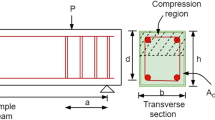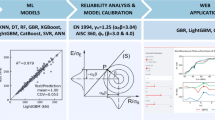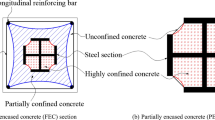Abstract
The shear capacity of steel beams is important for safe and efficient design in construction. Existing approaches have not accurately predicted the ultimate shear resistance of plate girders, but machine learning (ML) has emerged as a new technique to address this challenge. The Lazy Predict Python library automates the model selection and hyperparameter tuning process. In a recent study, up to 42 ML models based on Lazy Predict were applied to two datasets from 100 test results of varying specimens conducted by previous researchers. The XGB regressor model proposed in this study provided the highest performance, achieving an adjusted R squared of 0.9262 and 0.9417 R squared for the first dataset and an adjusted R squared of 0.9513 and 0.9692 R squared for the second dataset outperforming the other ML techniques in scikit-learn library. The values obtained from each test data were multiplied by the specimen’s estimated shear capacity using a theoretical technique, and these were compared with experimental results. The maximum shear force resulting from the proposed modified equation was calculated using two standards, EC3 and AISC proposal, to estimate the ultimate shear force. This study demonstrates that ML techniques can improve predictions of shear capacity in steel beams, which is crucial for safe and efficient construction design. The recommended model exhibited an appropriate level of accuracy in calculating the shear capacity of steel beams based on test data from earlier research and the current study. The datasets and codes utilized in this study can be freely accessed at https://github.com/amrrashed/Shear-Capacity-of-Steel-Beams-with-Flat-Webs-by-Using-Optimised-Regression-Learner-Techniques.








Similar content being viewed by others
Abbreviations
- A w :
-
Area of the web
- b :
-
The tension field width
- \({b}_{f}\) :
-
Flange breadth
- \({C}_{v}\) :
-
The ratio of buckling stress to shear stress (ASIC)
- \({d}_{w}\) :
-
Web depth
- \(E\) :
-
Steel modulus of elasticity
- K :
-
Plate buckling coefficient for shear
- \({L}_{a}\) :
-
Loading moment span length
- \({M}_{f}\) :
-
Flange bending moment
- N F.Sd :
-
Longitudinal force in the flange
- S c :
-
Plastic hinge location for the compression flange
- S t :
-
Plastic hinge location for the tension flange
- \({t}_{f}\) :
-
Flange thickness
- \({t}_{w}\) :
-
Web thickness
- V 3 :
-
Maximum shear capacity of plated steel girder calculated using Porter et al. [8] equations.
- \({V}_{\mathrm{ba}.\mathrm{Rd}}\) :
-
Maximum designated shear capacity of plated steel girder
- V bb.Rd :
-
Maximum shear capacity of plated steel girder calculated according to EC3 [51].
- V cr :
-
Web plate buckling load Hӧglund
- V E :
-
Maximum shear capacity of plated steel girder calculated using Hӧglund [7] equations
- \({V}_{\mathrm{exp}}\) :
-
Maximum shear recorded experimentally
- V f :
-
Shear resistances of the flanges
- V n :
-
Maximum shear capacity of plated steel girder calculated using AISC standard [50].
- V prop :
-
Maximum shear capacity of plated steel girder calculated using proposed Eq. (35)
- \({V}_{w}\) :
-
Web shear buckling capacity
- \({V}_{u}\) :
-
Ultimate shear capacity of steel beam
- \({\gamma }_{m}\) :
-
Partial material safety factor
- \(\theta \) :
-
The inclination of the membrane tensile yielding strength
- θ d :
-
Angle of panel diagonal
- \({\lambda }_{w}\) :
-
Web slenderness parameter
- μ :
-
Poisson’s ratio of steel
- \(\boldsymbol{\varphi }\) :
-
Modification factor
- \({\tau }_{\mathrm{ba}}\) :
-
Shear stress using simple post-critical design method
- \({\uptau }_{\mathrm{bb}}\) :
-
Shear buckling
- τu :
-
Ultimate shear stress
- \({\upsigma }_{\mathrm{bb}}\) :
-
Tension field stresses
- \({\sigma }_{t}^{y}\) :
-
Tensile yielding strength
- \({\sigma }_{\mathrm{yf}}\) :
-
Flange steel yield stress
- \({\sigma }_{\mathrm{yw}}\) :
-
Web steel yield stress
References
Höglund, T.: Shear buckling resistance of steel and aluminium plate girders. Thin-Walled Struct. 29, 13–30 (1997). https://doi.org/10.1016/S0263-8231(97)00012-8
Davies, A.W.; Griffith, D.S.: Shear strength of steel plate girder. Proc. Inst. Civ. Eng. Struct. Build. 134, 147–157 (1999). https://doi.org/10.1680/istbu.1999.31381
Sulyok, M.; Galambos, T.V.: Evaluation of web buckling test results on welded beams and plate girders subjected to shear. Eng. Struct. 18, 459–464 (1996). https://doi.org/10.1016/0141-0296(95)00180-8
Lee, S.C.C.; Davidson, J.S.S.; Yoo, C.H.H.: Shear buckling coefficients of plate girder web panels. Comput. Struct. 59, 789–795 (1996). https://doi.org/10.1016/0045-7949(95)00325-8
Lee, S.C.; Yoo, C.H.: Strength of plate girder web panels under pure shear. J. Struct. Eng. 124, 184–194 (1998). https://doi.org/10.1061/(ASCE)0733-9445(1998)124:2(184)
Shahabian, F.; Roberts, T.M.: Combined shear-and-patch loading of plate girders. J. Struct. Eng. 126, 316–321 (2000). https://doi.org/10.1061/(ASCE)0733-9445(2000)126:3(316)
Bradford, M.A.: Improved shear strength of webs designed in accordance with the LRFD specification. Eng. J. 33, 95–100 (1996)
Porter, D.M.; Rockey, K.C.; Evan, E.R.: The collapse behaviour of plate girders loaded in shear. Struct. Eng. 313−325 (1975)
Nethercot, D.A.; Byfield, M.P.: Calibration of design procedures for steel plate girders. Adv. Struct. Eng. 1, 111–126 (1997). https://doi.org/10.1177/136943329700100203
Barakat, S.; Mansouri, A.A.; Altoubat, S.: Shear strength of steel beams with trapezoidal corrugated webs using regression analysis. Steel Compos. Struct. 18(3), 757–773 (2015). https://doi.org/10.12989/scs.2015.18.3.757
Elamary, A.S.; Taha, I.B.M.: Determining the shear capacity of steel beams with corrugated webs by using optimised regression learner techniques. Materials 14, 2364 (2021). https://doi.org/10.3390/ma14092364
Dissanayake, M.; Nguyen, H.; Poologanathan, K.; Perampalam, G.; Upasiri, I.; Rajanayagam, H.; Suntharalingam, T.: Prediction of shear capacity of steel channel sections using machine learning algorithms. Thin-Walled Struct. 175, 109152 (2022)
Fang, Z.; Roy, K.; Ma, Q.; Uzzaman, A.; Lim, J. B.: Application of deep learning method in web crippling strength prediction of cold-formed stainless steel channel sections under end-two-flange loading. In Structures (Vol. 33, pp. 2903–2942). Elsevier (2021)
Fang, Z.; Roy, K.; Xu, J.; Dai, Y.; Paul, B.; Lim, J.B.: A novel machine learning method to investigate the web crippling behaviour of perforated roll-formed aluminium alloy unlipped channels under interior-two flange loading. J. Build. Eng. 51, 104261 (2022)
Fang, Z.; Roy, K.; Dai, Y.; Lim, J.B.: Effect of web perforations on end-two-flange web crippling behaviour of roll-formed aluminium alloy unlipped channels through experimental test, numerical simulation and deep learning. Thin-Walled Struct. 179, 109489 (2022)
Upasiri, I.; Konthesingha, C.; Nanayakkara, A.; Poologanathan, K.: Determination of elevated temperature material properties by ANN-based FE model. J. Struct. Fire Eng. (2023)
Fang, Z.; Roy, K.; Ingham, J.M.; Lim, J.B.: Assessment of end-two-flange web crippling strength of roll-formed aluminium alloy perforated channels by experimental testing, numerical simulation, and deep learning. Eng. Struct. 268, 114753 (2022)
Tapeh, A.T.G.; Naser, M.Z.: Artificial intelligence, machine learning, and deep learning in structural engineering: a scientometrics review of trends and best practices. Archives Comput. Methods Eng. 30(1), 115–159 (2023)
Akinosho, T.D.; Oyedele, L.O.; Bilal, M.; Ajayi, A.O.; Delgado, M.D.; Akinade, O.O.; Ahmed, A.A.: Deep learning in the construction industry: a review of present status and future innovations. J. Build. Eng. 32, 101827 (2020)
Dogan, A.; Birant, D.: Machine learning and data mining in manufacturing. Expert Syst. Appl. 166, 114060 (2021)
ELamary, A.S.: Cardiff theory: Web panel aspect ratio limits and their relation with inclination angle of membrane tensile yield strength. Int. J. Steel Struct. 16, 799–806 (2016). https://doi.org/10.1007/s13296-015-0189-7
ELamary, A.S.: Ultimate shear strength of composite welded steel-aluminium beam subjected to shear load. Int. J. Steel Struct. 16, 41–50 (2016). https://doi.org/10.1007/s13296-016-3004-1
Roberts, T.M.; Shahabian, F.: Design procedures for combined shear and patch loading of plate girders. In: Proceedings of the Institution of Civil Engineers-Structures and Buildings 140, no. 3. pp. 219–225 (2000)
S, E.A.; M., M.A.; Sharaky, I.A.; Mohamed, A.K.; Alharthi, Y.M.; Ali., M.A.M.: Utilizing artificial intelligence approaches to determine the shear strength of steel beams with flat webs. Metals. 13 no. 2 (2023)
Narayanan, R.; Rockey, K.C.: Ultimate load capacity of plate girders with webs containing circular cut-outs. In: Proceedings of the Institution of Civil Engineers, Part 2. pp. 845−862 (1981)
Der Avanessian, N.G.V.: Ultimate Strength of Plate Girders Containing openings in Webs, (1983)
Rockey, K.C.; Skaloud, M.: The ultimate load behavior of plate girders loaded in shear. Struct. Eng. 1, 29–48 (1972)
Evans, H.R.; Tang, K.H.: An investigation of the ultimate load behavior of longitudinally stiffened plate girder webs loaded predominantly in shear. (1983)
Tang, K.H.; Evans, H.R.: Transverse stiffeners for plate girder webs—an experimental study. J. Constr. Steel Res. 4, 253–280 (1984). https://doi.org/10.1016/0143-974X(84)90002-6
Kamtekar, A.G.; Dwiget, J.B.; Terelfall, B.D.: Tests on hybrid plate girders (Report 3), Cambridge (1974)
Rockey, K.C.; Valtinat, G.; Tang, K.H.: The design of transverse stiffeners on webs loaded in shear—an ultimate load approach. In: Proceedings of the Institution of Civil Engineers, Part 2. pp. 1069−1099. (1981)
Evan, E.R.; C.; R.K.; M, P.D.: Tests on longitudinally reinforced plate girders subjected to shear. In: Proceedings of Conference of Structural Stability, Preliminary Report. pp. 295−304, Liege (1977)
Longbottom, E.; Heymay, J.: Experimental verification of the strength of plate girders designed in accordance with the revised British Standard 153: tests on full scale model plate girders. In: Proceedings of the Institution of Civil Engineers. pp. 462–486 (1956)
Kamtekar, A.G.; Dwiget, J.B.; Terelfall, B.D.: Tests on hybrid plate girders (Report 2), Cambridge (1972)
Basler, K.; Yen, B.-T.; Mueller, J.A.; Thürlimann, B.: Web buckling tests on welded plate girders, Part 3: tests on plate girders subjected to shear. Welded Plate Girder Proj. Comm. 165, 48 (1960)
Skaloud, M.: Ultimate load and failure mechanism of thin webs in shear. In: Proceedings of Design of Plate and Box Girders for Ultimate Strength Colloquium, IABSE, London (1971)
Evans, E.R.; Rockey, K.C.; Tang, K.H.: An investigation into the rigidity of longitudinal web stiffeners for plate girders. (1979)
Adorisio, D.: Model studies on plate girders subject to shear loading. (1982)
Evans, H.R.: Longitudinally and transversely reinforced plate girders. Plated Structures. In: Stability and Strength, R. Narayanan, Elsevier, Applied Science. pp. 1–37, London (1983)
Evans, H.R.: A report on the full scale tests on a girder with a stiffened web subjected to combined shear and bending loads (1984)
Frey, F.; Anslijn, R.: Shear tests on unstiffened plate girders. In: Proceedings of the Second International Colloquium on the Stability of Steel Structures, ECC3. pp. 321−326, Liege (1977)
Evans, H.R.: An appraisal, by full scale testing, of new design procedures for steel girders subjected to shear and bending. In: Proceedings of the Institution of Civil Engineers, Part 2. pp. 175−189. (1986)
Carskaddan, P.S.: Shear buckling of unstiffened hybrid beams. In: Proceedings of ASCE, Structural Division, 94, No. ST8. pp. 1965−1990. (1968)
B., C.P.; S., L.H.; T, Y.B.: Welded constructional alloy steel plate girders. In: Proceedings of ASCE, Structural Division. pp. 1−36. (1964)
Konishi, I.: Theory and experiment of load carrying capacity of plate girders. Research committee, Kansai District, Japan (1965)
Sakai, F.; Fujii, T.; Fukucei, Y.: Failure tests of plate girders using large-sided models, Tokyo (1966)
Bergfelt Allan; Hövik, Jardar: Thin-walled deep plate girders under static loads. In: Proceedings of the IABSE Colloquium, New York (1968)
Timoshenko, S.P.; Gere, J.M.: Theory of elastic stability. McGraw-Hill (1985)
BS 5950: Part 1.: Structural use of steel work in building. code of practice for design–rolled and welded sections. British Standards Institution (2000)
AISC: Specification for structural steel buildings, an American National Standard. Am. Inst. Steel Constr. Chicago. 612 (2016)
1993–1–1, E.: Eurocode 3 : Design of steel structures—Part 1–1: General rules and rules for buildings. European Committee for Standardization (CEN), Brussels (2005)
Baştanlar, Y.; Ozuysal, M.: Introduction to machine learning second edition. (2014)
Ethem Alpaydın: introduction to machine learning. The MIT press (2014)
Russell, R.: Machine learning step-by-step guide to implement machine learning algorithms with Python. 106 (2018)
Badillo, S.; Banfai, B.; Birzele, F.; Davydov, I.I.; Hutchinson, L.; Kam-Thong, T.; Siebourg-Polster, J.; Steiert, B.; Zhang, J.D.: An introduction to machine learning. Clin. Pharmacol. Ther. 107, 871–885 (2020). https://doi.org/10.1002/cpt.1796
Brownlee, J.: Regression metrics for machine learning. (2021)
Ghoneim, S.S.M.; Farrag, T.A.; Rashed, A.A.; El-Kenawy, E.S.M.; Ibrahim, A.: Adaptive dynamic meta-heuristics for feature selection and classification in diagnostic accuracy of transformer faults. IEEE Access 9, 78324–78340 (2021). https://doi.org/10.1109/ACCESS.2021.3083593
Lazy Predict Library |Lazy Predict—Best suitable model for you
Agrawal Raghav: Evaluation metrics for your regression model—Analytics Vidhya
API Reference—scikit-learn 1.1.2 documentation
EN 10002–1:2001–12: Metallic materials—Tensile testing—Part 1: Method of test at room temperature. , Beuth Verlag, Berlin (2001)
Acknowledgements
The researchers would like to acknowledge Deanship of Scientific Research, Taif University, Taif, Saudi Arabia, for funding this work.
Author information
Authors and Affiliations
Corresponding author
Appendix 1
Appendix 1
The rest of the results conducted by Lazy Predict function for 21 ML models (for DB1) | ||||
|---|---|---|---|---|
Time taken | RMSE | R Squared | Adjusted R Squared | Model |
0.0482 | 0.0550 | 0.8044 | 0.7523 | 1-Decision tree regressor |
0.0449 | 0.0591 | 0.7785 | 0.7194 | 2-Extra tree regressor |
0.0524 | 0.0951 | 0.7031 | 0.6239 | 3-Transformed target regressor |
0.0683 | 0.0951 | 0.7031 | 0.6239 | 4-Linear regression |
0.0527 | 0.0951 | 0.7031 | 0.6239 | 5-Lars |
0.0451 | 0.0957 | 0.7015 | 0.6219 | 6-Ridge |
0.0515 | 0.1006 | 0.6835 | 0.5991 | 7-RidgeCV |
0.0508 | 0.1285 | 0.5351 | 0.4111 | 8-Orthogonal matching pursuit |
0.5351 | 0.1370 | 0.2558 | 0.0574 | 9-RANSAC regressor |
0.0471 | 0.1704 | −0.0190 | −0.2907 | 10-LassoLars |
0.0613 | 0.1704 | −0.0190 | −0.2907 | 11-ElasticNet |
0.0404 | 0.1704 | −0.0190 | −0.2907 | 12-Dummy regressor |
0.0484 | 0.1704 | −0.0190 | −0.2907 | 13-Lasso |
0.1685 | 0.0865 | −0.2772 | −0.6178 | 14-MLP regressor |
0.0537 | 0.3248 | −1.9127 | −2.6894 | 15-Kernel ridge |
0.0992 | 6.0288 | −1078.8600 | −1366.8200 | 16-Gaussian process regressor |
The rest of the results conducted by Lazy Predict function for 42 ML models (for DB2) | ||||
|---|---|---|---|---|
Time taken | RMSE | R Squared | Adjusted R Squared | Model |
0.1893 | 0.1478 | 0.9449 | 0.9128 | 1-XGB regressor |
0.0623 | 0.1496 | 0.9436 | 0.9107 | 2-Bagging regressor |
0.0309 | 0.1538 | 0.9404 | 0.9057 | 3-SVR |
0.0192 | 0.1564 | 0.9384 | 0.9025 | 4-NuSVR |
0.2372 | 0.1702 | 0.9270 | 0.8845 | 5-RANSAC regressor |
0.0159 | 0.1765 | 0.9215 | 0.8757 | 6-Ridge |
0.1622 | 0.1772 | 0.9209 | 0.8747 | 7-LassoCV |
0.1902 | 0.1774 | 0.9207 | 0.8744 | 8-ElasticNetCV |
0.0106 | 0.1778 | 0.9203 | 0.8739 | 9-Bayesian ridge |
0.0203 | 0.1812 | 0.9173 | 0.8690 | 10-RidgeCV |
0.0126 | 0.1824 | 0.9162 | 0.8673 | 11-LassoLarsIC |
0.0511 | 0.1824 | 0.9162 | 0.8673 | 12-LassoLarsCV |
0.0586 | 0.1824 | 0.9162 | 0.8673 | 13-LarsCV |
0.0204 | 0.1824 | 0.9162 | 0.8673 | 14-Lars |
0.0150 | 0.1824 | 0.9162 | 0.8673 | 15-Transformed target regressor |
0.0317 | 0.1824 | 0.9162 | 0.8673 | 16-Linear regression |
0.0321 | 0.1894 | 0.9096 | 0.8568 | 17-Orthogonal matching pursuit CV |
0.0641 | 0.1909 | 0.9081 | 0.8545 | 18-Huber regressor |
0.0129 | 0.1979 | 0.9014 | 0.8438 | 19-SGD regressor |
0.0313 | 0.1985 | 0.9008 | 0.8429 | 20-LinearSVR |
0.0317 | 0.1989 | 0.9003 | 0.8422 | 21-Decision tree regressor |
0.3363 | 0.2437 | 0.8503 | 0.7630 | 22-Hist gradient boosting regressor |
0.0305 | 0.2467 | 0.8467 | 0.7572 | 23-Poisson regressor |
0.0277 | 0.2590 | 0.8309 | 0.7323 | 24-Orthogonal matching pursuit |
0.1265 | 0.2835 | 0.7974 | 0.6793 | 25-LGBM regressor |
0.2843 | 0.3137 | 0.7520 | 0.6073 | 26-MLP regressor |
0.0315 | 0.3303 | 0.7251 | 0.5648 | 27-Tweedie regressor |
0.0156 | 0.3360 | 0.7155 | 0.5496 | 28-Extra tree regressor |
0.0417 | 0.3363 | 0.7151 | 0.5489 | 29-Gamma regressor |
0.0162 | 0.3966 | 0.6037 | 0.3726 | 30-Passive aggressive regressor |
0.0156 | 0.5961 | 0.1045 | −0.4179 | 31-ElasticNet |
0.0128 | 0.6300 | 0.0000 | −0.5833 | 32-LassoLars |
0.0159 | 0.6300 | 0.0000 | −0.5833 | 33-Lasso |
0.0316 | 0.6300 | 0.0000 | −0.5833 | 34-Dummy regressor |
0.1912 | 0.6658 | −0.1171 | −0.7688 | 35-Quantile regressor |
0.0160 | 1.4018 | −3.9515 | −6.8399 | 36-Kernel ridge |
0.0403 | 2.8079 | −18.8674 | −30.4567 | 37-Gaussian process regressor |
Rights and permissions
Springer Nature or its licensor (e.g. a society or other partner) holds exclusive rights to this article under a publishing agreement with the author(s) or other rightsholder(s); author self-archiving of the accepted manuscript version of this article is solely governed by the terms of such publishing agreement and applicable law.
About this article
Cite this article
Elamary, A.S., Sharaky, I.A., Alharthi, Y.M. et al. Optimizing Shear Capacity Prediction of Steel Beams with Machine Learning Techniques. Arab J Sci Eng 49, 4685–4709 (2024). https://doi.org/10.1007/s13369-023-08132-w
Received:
Accepted:
Published:
Issue Date:
DOI: https://doi.org/10.1007/s13369-023-08132-w




